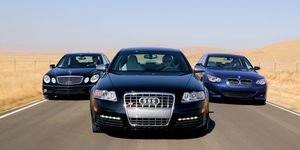This is a story about $10,000. That’s the difference in base price between the 2020 Audi S6 sedan and its almost mechanically identical brother, the sleeker, swoopier, sexier S7 luxo-hatch. How much is sleek, swoop, and sexy worth?
Before speculating about the relative worth of seductive styling, we’re going to dig into the extensive technology beneath the pretty skin.
At the heart of both the S6 and S7 is a twin-turbocharged and supercharged 2.9-liter V-6 code-named EA839. This engine replaces the twin-turbocharged EA834 4.0-liter V-8 used in the prior generation of the pair—which was rated at 450 horsepower and generated 406 lb-ft of torque from as low as 1400 rpm. The EA839 V-6 and its electrical companion components give up six horses to the V-8. But 444 horsepower is still pretty dang mighty, and its 443 lb-ft of peak torque production is a good 37 more than the old V-8.
Putting the exhaust-driven turbochargers in the valley between the cylinder banks is standard practice now with Audi’s V-configured engines. Having the exhaust ports aimed into the vee at the turbos results in a very short trip for exhaust gases that spin the turbines. That means quicker throttle response. However, that’s not enough.
The S6 and S7 are Audi’s first products in the United States to utilize a 48-volt electric supercharger. The liquid-cooled electric compressor hangs low on the left side of the engine between the turbos and the air-to-liquid intercooler. To increase throttle response, the electric blower generates boost while the turbos spool up to speed. Heck, wired up right it could produce boost even when the engine is turned off and cold. Add this latest trick in with the talents of direct injection, variable-valve timing, and smart-guy ignition timing, and the result is an astonishingly easygoing, ridiculously smooth, ludicrously responsive V-6. And then, beyond all that, there’s the hybrid system making its direct contribution of twist as well.
The boosted V-6 feeds Audi’s version of the ubiquitous ZF eight-speed automatic transmission. The ZF, which is used in everything from the Rolls-Royce Dawn to the Dodge Hellcats, is a conventional automatic with a torque converter similar in concept to the two-speed Powerglide optional in the 1962 Chevrolet Nova. Careful programming means it always works well. Rumors are that the ZF is so dominant that it’ll soon show up in several Schwinn exercise bikes and the latest Caterpillar mining trucks.
Then, after all that, is Audi’s Quattro all-wheel-drive system. Yes, the Quattro system works well. A torque-vectoring rear differential is available and adds some calculated torque distribution to the rear tires for better rotation and balance through corners. Of course, there’s the traction control, stability control, and anti-lock-braking technology. Nothing surprising there. What’s so satisfying is how well Audi has integrated all this tech to work seamlessly almost to the point of invisibility. And despite all the insulation that comes from all the computers making it all work, the S6 still has an engaging mechanical character.
Snick the paddle behind the steering wheel into a lower gear, and the whole S6 seems to squat down on its adaptive air suspension in eager anticipation of a corner. The optional four-wheel steering seems to work, but its effect isn’t detectable unless there’s another S6 on hand without the system to make a direct comparison.
At the apex of a corner, as the driver starts to roll into the throttle, the response from the engine is gloriously progressive and inimitable. There are sedans that pack more brute wallop, but none that delivers power in a more engaging manner. This is a car that romps like a happy husky, bites into corners like a wolf, and then runs like whatever the wolf is hunting. Audi claims the S6 runs from zero to 60 mph in 4.4 seconds, which is a tenth quicker than the heavier S7. In our testing, an S7 found 60 mph in 4.1 seconds, so we’d guess that the S6 could do it in about four.
From the inside, the S6 and S7 aren’t much different from each other. There are some different surfaces and finishes, but the dash shapes are the same, and Audi’s three-screen digital interface is identical. With haptic feedback built into the center screens and some familiarity with the menus, it’s fairly easy to manage the S6’s intense number of electronic gadgets, navigation systems, and various safety technologies.
Right now with its poised manner, excellent ride, beautiful interior, and buffet of tech stuff, the current mid-size Audi—dubbed C8—is flat wonderful. So why does Audi ask another $10,000 for the S7?
While the S7 is an attractive car, it isn’t as if the S6 is hard to look at. And the S6 has an inch more headroom in both the front and rear, plus more shoulder room and almost a half inch more rear legroom. About the only practical advantage the S7 offers is an additional 11 cubic feet of cargo room under its hatchback. That’s important if you’re building a pool house and expect to make a lot of trips to Home Depot for lumber.
Sex appeal matters, though. So, the S6 starts at $74,895 while the S7’s base price is $84,895. About the only significant equipment difference is apparently that the S7 gets standard LED taillights; they’re optional on the S6. Ten grand is a lot to pay for fancy taillights.
Get the S6.
Source: Reviews - aranddriver.com






